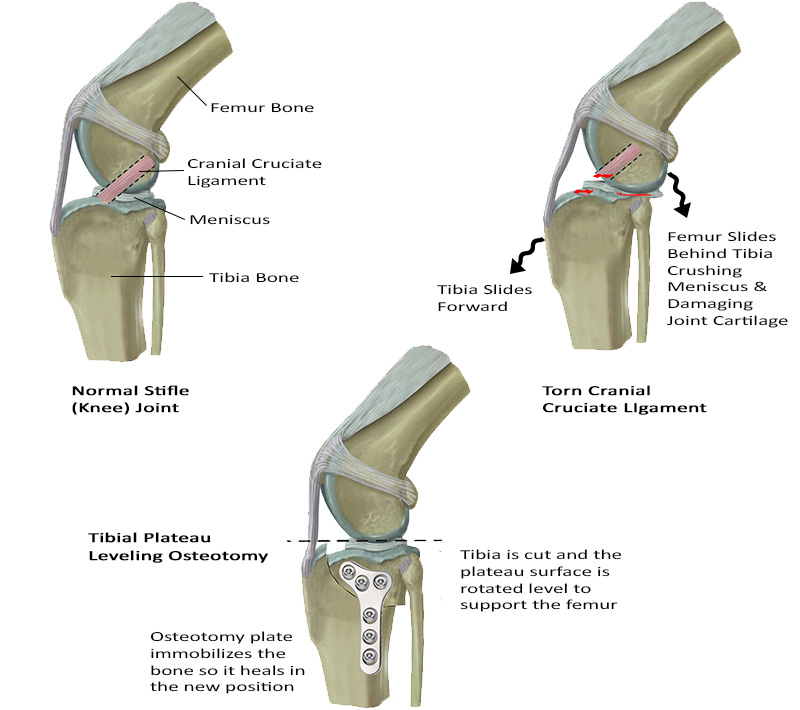Tibial Plateau Leveling Osteotomy ( TPLO ) Surgery for Dogs in the Kansas City Area
If your dog has suffered a cranial cruciate ligament (CCL) injury in their knee joint, also known as an ACL injury, Tibial Plateau Leveling Osteotomy (TPLO) surgery could be the best solution to alleviate their pain and restore mobility. Dr. Joe Rodier is an experienced Slocum TPLO Certified Veterinarian who has been performing expert TPLO surgery for dogs in Blue Springs and the surrounding Kansas City communities since 2006.
With over 30 years of experience in advanced orthopedic procedures, Dr. Rodier is a trusted TPLO surgeon who receives many referrals and 2nd opinion requests from local veterinarians throughout Kansas and Missouri. Dr. Rodier provides the TPLO surgery on dogs 3-4 times per week and has performed over 4000 TPLO surgeries with excellent patient outcomes.
New clients can schedule a complimentary second opinion exam and consultation. Dr. Rodier will personally evaluate your dog, answer your questions, and determine if TPLO surgery is the right option for your pet.
Read More...
⇒ Client experiences and reviews of TPLO Surgery at Blue Springs Animal Hospital
⇒ Torn Cranial Cruciate Ligaments in Dogs: Anatomy, Causes, Symptoms, Diagnosis
⇒ TPLO Surgery: Treatment options, How it works, How we do it at Blue Springs Animal Hospital
⇒ TPLO Surgery: Potential risks and Choosing the best veterinary surgeon
⇒ Alternate Procedures: MMP-TTA and Anchor Lock for small dogs
What is a Cranial Cruciate Ligament (CCL) injury in dogs?
The Cranial Cruciate Ligament (CCL) in dogs is similar to the Anterior Cruciate Ligament (ACL) in humans. In both species the ligament is an important structural support in the knee joint. Because humans walk upright the mechanics and treatment options for dogs are a little different to account for the unique forces affecting the knee (stifle) joint in dogs.
The illustration below shows the anatomy of a normal dog knee joint with an intact and a torn cranial cruciate ligament. The cranial cruciate ligament normally keeps the femur bone in position on top of the tibia, with the meniscus (a cartilage pad) acting as a cushion between the bones.
When the CCL is torn in dogs the tibia falls forward (called tibial thrust) and the femur slides down the back of the tibia. This abnormal movement is called a “positive cranial drawer sign” and can be identified by a veterinarian when examining the leg. With each step the femur slides back crushing the meniscus and scraping the joint surface causing pain and damage to the joint. If the joint is not stabilized it will develop painful arthritis and permanently limit the dog’s mobility and enjoyment of normal activities.
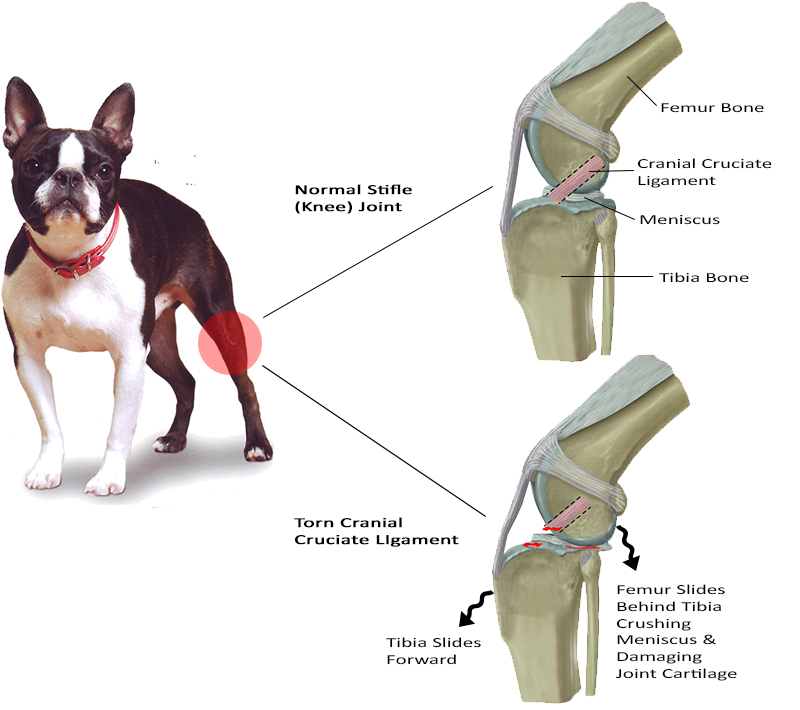
What causes a dog's Cranial Cruciate Ligament (CCL) to rupture or tear?
Rupture of the cranial cruciate ligament (CCL) is one of the most common orthopedic conditions in dogs. A report in the Journal of the American Veterinary Medical Association in 2008 found an incidence of around 11% of the canine population that is affected. [1]
In people the ACL is commonly injured due to high impact trauma such as we hear about happening to professional athletes. In dogs it is less common for a tear to occur traumatically in an otherwise healthy ligament. Usually the ligament tears as the end result of gradual degeneration and weakening of the ligament tissue due to predisposing factors. According to a review paper in Veterinary Sciences published in 2021 [2], the following conditions have been identified as probable factors leading to degenerative changes:
-
Obesity: Increased weight causes stress on the ligament as it attempts to prevent the femur bone from sliding downhill. Fat tissue may also excrete inflammatory mediators which contribute to degradation of the tissue.
-
Sedentary lifestyle: Lack of regular exercise results in weakened muscular support for the joint which increases the burden on the ligament to stabilize the joint.
-
Age: There is gradual degeneration and loss of strength within the ligament with increasing age.
-
Breed: CCL tears can occur in any breed, but most commonly it is seen in large breeds dogs. There has also been a reported increased incidence in certain dog breeds (such as Rottweiler, Newfoundland, Staffordshire Terrier, Mastiff, Akita, Saint Bernard, Chesapeake Bay Retriever and Labrador Retriever).
-
Sex: There is a higher reported incidence in females and neutered males. (The exact reason for this finding is unknown and the benefits of neutering may outweigh this increased risk.)
-
Leg Conformation: Sub-optimal leg anatomy can cause poor alignment of the bones and excessive slope on the top of the tibia. Excessive slope exerts constant pressure on the ligament to hold the bones in proper position.
-
Genetics: More research is needed, but genes have been identified that could be responsible for the strength and structure of the ligament. A study in the Journal of the American Veterinary Medical Association showed inheritance of CCL disease in the Newfoundland breed. [3]
Maintaining a healthy weight and regular daily physical activity are the primary variables that a pet owner can positively impact.
What are the signs or symptoms of a torn or ruptured Cranial Cruciate Ligament in dogs?
According to the American College of Veterinary Surgeons (ACVS), the most common signs (symptoms) reported in dogs with cranial cruciate ligament disease include some combination of the following:
- difficulty rising from a sitting position
- difficulty in the process of sitting (“positive sit test”)
- trouble jumping into the car (or onto furniture)
- decreased activity level or unwillingness to play
- lameness (limping) of variable severity, sometimes only noted after long periods of rest
- muscle atrophy (decreased muscle mass in the affected leg)
- decreased range of motion of the knee joint
- a popping / clicking noise (which may indicate a meniscal tear)
- firm swelling on the inside of the shin bone (fibrosis or scar tissue)
- pain
- stiffness
The ACVS notes that “pain and discomfort are expressed differently in people compared to dogs, so although dogs may not whine, cry out, or hold up their affected limb constantly, the persistence of their lameness is pain.” [4]
The symptoms may differ depending on the cause and severity of the problem and may change over time. Most commonly there are mild episodes of intermittent lameness as the ligament gradually deteriorates. Once the ligament completely ruptures there will usually be significant lameness (hopping on 3 legs), which may be followed by the dog gradually starting to bear partial weight again.
If a dog has mild intermittent symptoms and a weakened ligament that has not yet torn veterinarians will refer to it as a “partial tear” of the ligament. The American College of Veterinary Surgeons (ACVS) notes that “partial tearing of the CrCL is common in dogs and almost always progresses to a full tear over time.” [4]
The dog in video clip below is limping on the right hind leg due to pain in the knee caused by a torn cranial cruciate ligament:
How is a torn Cranial Cruciate Ligament diagnosed?
Cranial cruciate ligament injuries are diagnosed based upon symptoms, physical examination, and diagnostic radiographs.
Physical Examination For A Torn Cranial Cruciate Ligament
An experienced veterinarian can manipulate and palpate the joint to detect abnormal movement of the bones that is characteristic of a torn cranial cruciate ligament. Without a functioning cruciate ligament the tibia will move forward (called cranial tibial thrust) and the femur will slide backward in what is commonly referred to as a “positive cranial drawer movement.” If the dog is relaxed enough the veterinarian can detect the movement while the dog is awake. If the dog is holding the muscles tense (due to pain and anxiety), or if the ligament is only partially torn, then sedation may be required to detect the abnormal cranial drawer movement.
Dr. Rodier demonstrates a positive cranial drawer movement in the video below:
Radiographs (X-rays) Of A Dog's Knee With A Torn Cranial Cruciate Ligament
Following initial diagnosis and as part of the evaluation for TPLO surgery, the knees will be radiographed. In the x-rays below, the first X-ray shows a normal leg with the femur in proper position on top of the tibia. In the second x-ray, the ligament is torn, and the femur has slid backwards down the slope of the tibia. On the abnormal x-ray, the doctor has taken some measurements and marked the x-ray in preparation for the TPLO procedure.

What are the treatment options for a torn Cranial Cruciate Ligament in dogs?
The best treatment option for your pet is dependent on multiple factors including age, breed, weight, body condition, conformation, activity level, and the degree of instability in the knee.
The first major decision is between non-surgical (medical or conservative) treatment and surgical treatment. While small dogs less than 30 lbs may recover acceptable function without surgery, the evidence strongly suggests that dogs who receive surgical treatment have better results.
As illustrated in the anatomy section above, loss of the cranial cruciate ligament allows the femur to slide down the back of the tibia with each step. That instability creates continued damage to the joint which leads to development of painful arthritis. According the American College of Veterinary Surgeons (ACVS), “Due to biological and mechanical influences, the CrCL has no ability to heal once tearing begins regardless of the degree of severity.” They state that “surgical treatment is typically the best treatment for CrCLD since it is the only way to permanently control the instability present in the knee joint.” [4]
Surgery is particularly important for overweight dogs and any dog who weighs more than 30 lbs regardless of body condition. A study published in Veterinary Surgery found that 80% of dogs weighing more than 33 lbs will not improve with medical management and continue to experience long term pain and lameness. [5]. Another study published in The Journal of the American Veterinary Medical Association found that surgically treated dogs had better functional use of the leg and a significantly higher probability of a successful outcome (67.7%, 92.6%, and 75.0% for 12-, 24-, and 52-week evaluations) than non-surgically treated dogs. [6]
Is TPLO Surgery the best surgery for a torn Cranial Cruciate Ligament?
Dr. Rodier has completed many hours of advanced training and has 30+ years of experience performing surgery on the canine knee using different techniques. There are several options available today which may be recommended, including the TPLO, the MMP TTA, the Tightrope procedure, and the Anchor Lock procedure for small dogs. Dr. Rodier is experienced with each of these and can determine which surgery is the best option based upon your pet’s specific situation.
TPLO is the surgery recommended most often because it fits the widest variety of cases and provides the most consistently positive outcome. This procedure has been in practice now for over 20 years and has been thoroughly tested with over 200 research studies published. It is considered by most veterinary surgeons to be the gold standard against which all other procedures are compared.
A comparative study published in the journal of Veterinary Surgery demonstrated that patients receiving TPLO surgery had a 93% return of limb function one year after surgery. [7]
Compared to other options, TPLO surgery is generally considered to provide:
- faster recovery
- more range of motion for the joint
- a better return to athletic or working activity
- less long term arthritis and pain
How does the TPLO surgery work?
Tibial Plateau Leveling Osteotomy (TPLO) surgery levels the top of the tibia, called the “Tibial Plateua”, and creates a stable surface for the femur to rest upon. This stabilizes the femur and eliminates the abnormal sliding action that is causing damage to the joint.
To accomplish leveling of the tibia, the top of the tibia is cut and rotated to realign it under the femur. A metal plate is placed to hold the bone in position while it heals into this new alignment.
The change in biomechanics of the joint after TPLO eliminates the need for a cranial cruciate ligament so it will be trimmed or removed during surgery. The meniscus will also be examined and any damaged areas will be removed to reduce pain and inflammation.
Once the bone has healed the new anatomy of the joint is permanent and the bone plate is no longer needed. The plate does not usually cause any problems and is left in place. Only about 3-5% of patients will have an issue with it and require removal.
The illustrations below demonstrate how the TPLO surgery works:
This video provides an excellent animation of the anatomy and how the TPLO surgery stabilizes the knee:
What is the procedure for TPLO Surgery at Blue Springs Animal Hospital?
- The patient is fasted at home the night prior to surgery to prevent regurgitation of food during anesthesia.
- Patients receive a complete physical examination and blood work is evaluated to ensure the patient is in good health prior to anesthesia.
- The dog is sedated with a pre-medication to reduce anxiety, antibiotics are administered to prevent infection, and several pain medications are administered to control pain during and after surgery.
- An IV catheter is placed to provide easy access for administration of IV medications and to provide IV fluids for cardiovascular support during anesthesia. We use an IV pump for accuracy and an IV warmer to make the patient more comfortable and maintain body temperature under anesthesia.
- Xrays are obtained prior to surgery to evaluate the joint and take measurements of the angles needed for the surgery.
- Patients are anesthetized with injectable medication and a tracheal tube is placed to administer oxygen and inhalant (gas) anesthesia.
- Registered veterinary technicians carefully observe the patient while under anesthesia using sophisticated monitors to document vital signs including heart rate, ECG, blood pressure, body temperature, and CO2.
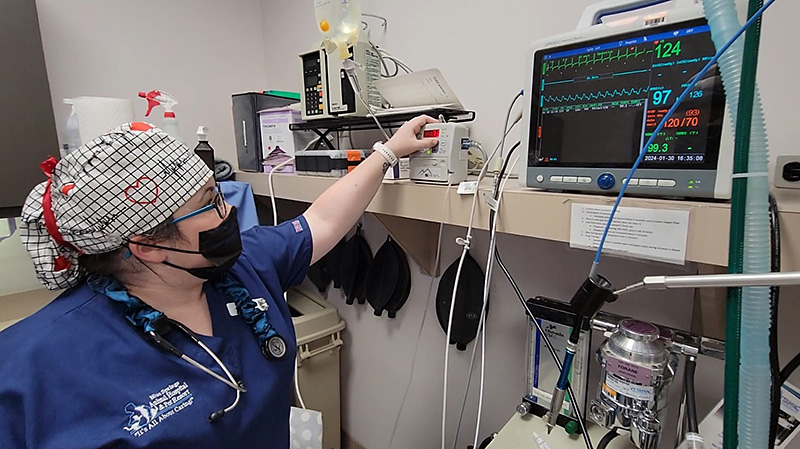
- The leg and spine area are shaved and scrubbed to disinfect for the epidural and the surgery site.
- An epidural is administered to numb the leg prior to surgery. Pain control is a top priority and we provide multiple types of pain control including IV and epidural medications. Pain medication is provided pre-operatively so it is effective during the surgery and continued after surgery for several weeks.
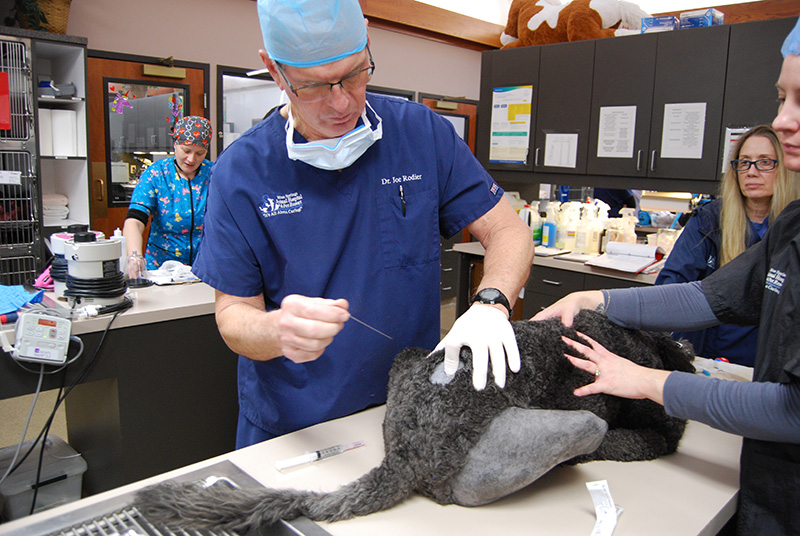
- The patient is transferred to the surgery suite and the leg is suspended and aseptically scrubbed a 2nd time prior to surgery.
- The skin is incised with a scalpel and the underlying tissues are incised with a CO2 laser which seals the vessels and nerves to reduce bleeding and pain sensation.
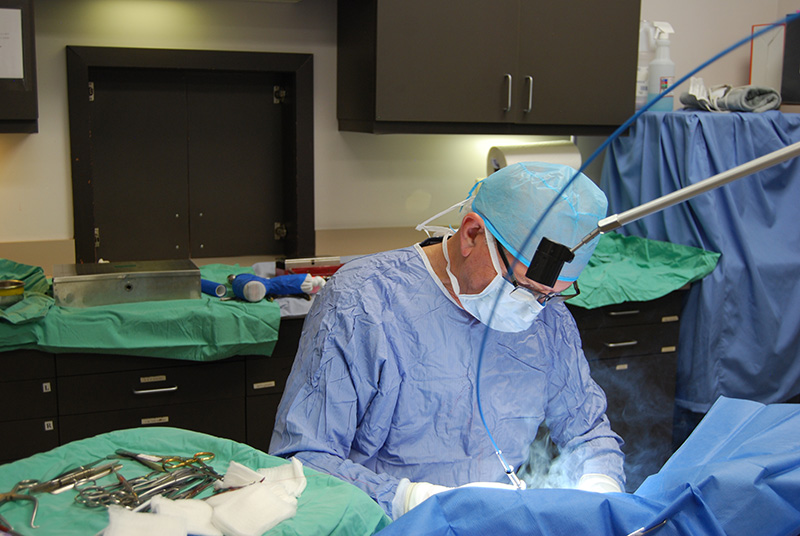
- The joint is inspected and the torn ligament and meniscus are removed if needed to reduce inflammation.
- A curved saw is used to make the osteotomy incision and pins are placed to rotate the bone. The plate is applied to secure the bone in the new position and the incision is closed.
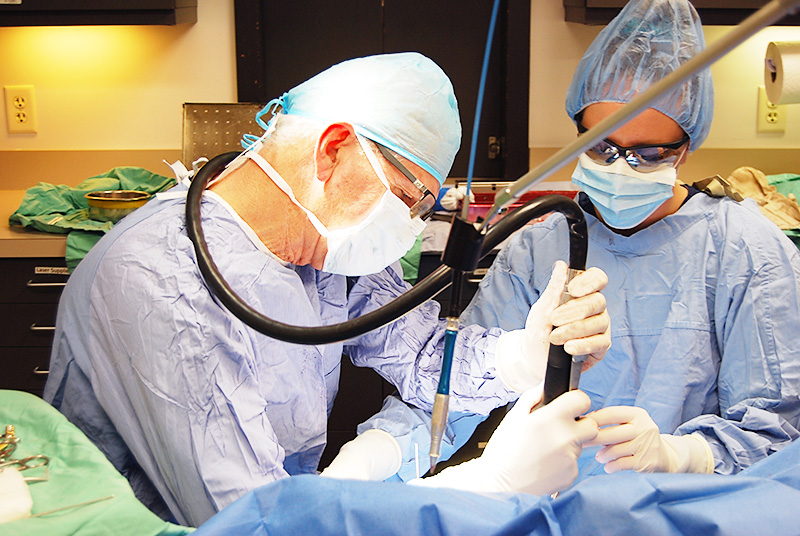
- Postoperative Xrays are taken to assess the new tibial plateau angle and verify correct positioning of the plate and screws. In the X-rays below, the leg has been corrected by TPLO, and the femur is now resting securely on top of the tibia, in a similar position to the normal joint.
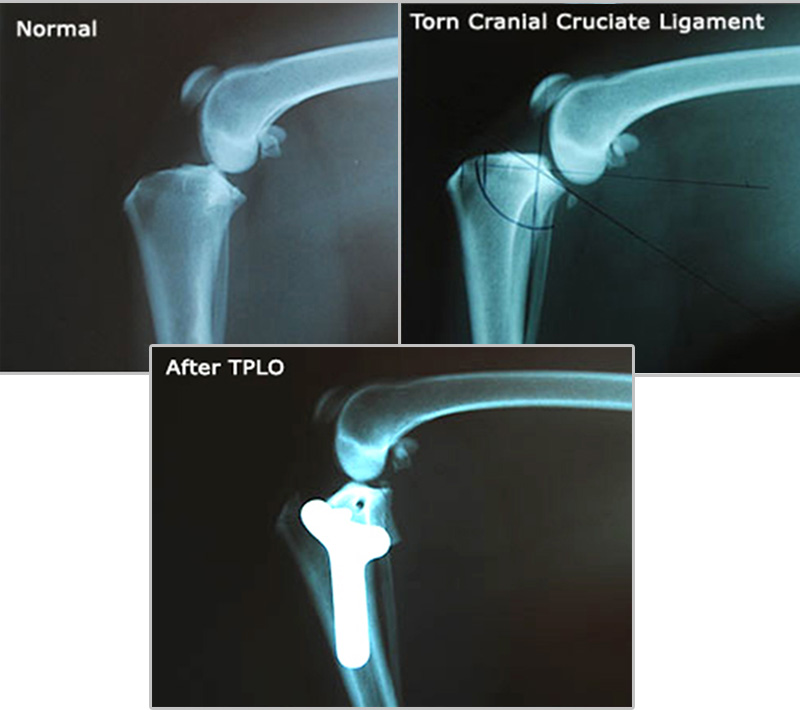
- We keep the patient overnight to continue injectable pain medication and the veterinarian does another exam the next day prior to releasing them to go home.
What are the potential risks or complications with TPLO surgery in dogs?
Research indicates that only 2-4% of TPLO surgeries experience a serious complication, but complications can be reduced with “increased surgeon experience, careful surgical planning, and accurate execution of the surgical procedure”. [8] To minimize complications related to surgical technique it is important to choose a veterinarian with advanced training and extensive experience with positive patient outcomes. Other common concerns related to TPLO surgery include:
- Anesthetic Complications: We minimize the chances of an anesthetic complication by assessing the pet’s health prior to anesthesia and providing close monitoring by registered veterinary technicians with state of the art equipment.
- Infection: Antibiotics are administered and extensive precautions are taken to ensure surgical sterility. Pet parents need to provide a clean and sanitary environment when the dog goes home to assist in avoiding infections. We will also send home an E-Collar and a leg sleeve to prevent the dog from licking and contaminating the surgery site.
- Bending or breakage of the plate or screws: This is generally due to falls or excessive activity (jumping or running) in the post op period before the bone has healed. Dogs feel so much better after surgery that pet parents become lax and allow them too much freedom too quickly. We will send home specific post op care instructions and it is important that the restrictions are enforced.
- Meniscal tears or inflammation: Meniscal injuries are commonly evident and corrected during surgery, but in rare cases the meniscus (or remnant of the meniscus) will cause problems after surgery and require additional treatment in the future.
- Implant Removal: Approximately 3-5% of dogs will need to have the plate removed in the future due to infection or irritation that can occur weeks, months, or years later.
What factors are important when choosing the best veterinarian to perform TPLO surgery on your dog?
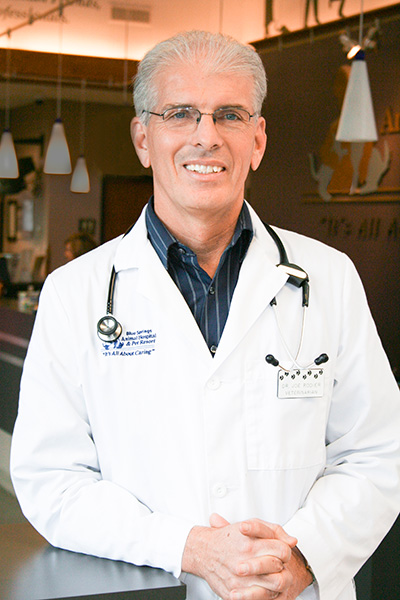
Deciding if your dog should have TPLO surgery and which veterinarian should do the surgery are important decisions. TPLO surgery has a steep learning curve and should be performed by a Veterinarian with advanced training for the procedure and extensive experience with successful patient outcomes.
Dr. Joe Rodier has 30+ years of experience and a record of success with advanced orthopedic procedures. When the TPLO procedure was developed Dr. Rodier recognized it as a superior procedure to the other available options and sought advanced training.
In 2006 Dr Rodier became Slocum Certified to perform the TPLO Surgery. In addition he trained one-on-one with a board certified veterinary surgeon who is a Diplomate of the American College of Veterinary Surgeons.
Since 2006 Dr. Rodier has performed the TPLO surgery on over 4000 dogs with excellent results. Dr. Rodier receives many referrals and 2nd opinions every year from local veterinarians in Kansas and Missouri and currently maintains a caseload of 3-4 TPLO surgeries per week.
Dr. Rodier is available for consultation, second opinions, or referrals for the TPLO surgery procedure. Dr. Rodier will provide a complimentary 2nd opinion consultation and exam free of charge for new clients to determine if the TPLO surgery is the right procedure for their pet.
What kind of post op care is required for your dog after TPLO surgery?
Recovery from TPLO surgery is more rapid and complete than for other procedures used in the past. Some dogs will start bearing weight within 24 hours after surgery, and almost all dogs are starting to put weight on the leg within 2 weeks. Generally within 2-3 months the leg is fully healed.
The most common complications we see in TPLO patients are due to falls or excessive activity before the bone has healed. The dog may feel better and want to be active, but it is very important to restrict the dog’s activity to prevent falling, running, jumping, playing with other dogs, or any activity which could result in trauma to the surgery site.
- Controlled walking on a short leash is the only activity allowed in the 12 weeks following surgery. A sling under the belly will be recommended to support the dog while leash walking to prevent falling on the leg.
- When off leash the dog must be confined to a crate. It is important to always have the dog on a non-slippery surface when off leash without a belly support.
- Specific written instructions will be provided after surgery and restrictions will gradually be lifted during recheck appointments as healing progresses.
- On a case by case basis, the doctor will recommend physical activities to maintain strength in the muscles while the leg heals.
Alternate procedure: MMP TTA, Anchor Lock for small dogs

Customer Reviews of TPLO Surgery at Blue Springs Animal Hospital In Kansas City
Dr. Rodier saved my dogs knee! I’m forever grateful and will always refer this Dr and hospital to anyone I can. Not only do they have the skill, but the staff were extremely friendly and informative. The Dr answered all my questions with knowledge and compassion. This place cares… simple as that. – Mike Hanson
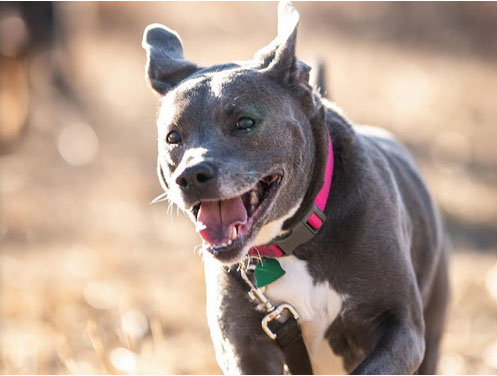
We brought our 1.5 year old goldendoodle to BSAH for TPLO surgery for a torn ACL. We were referred from our usual vet to Dr. Rodier and from the first phone call with him, we felt like family and like we were supported. Every question we had was answered beforehand and they worked with us to understand exactly how much we would owe for the surgery going into it. On the day of the surgery, check in was quick and easy - front desk staff was kind and welcoming. We were so afraid to leave our girl but Dr. Rodier provided text message updates frequently to let us know how our doodle was doing when she was staying with them to be monitored.
One of the best parts of this experience though has been the communication with the on-call doctor, Dr. Moorehead. We had questions about the incision site and the bandages once we brought our doodle home and called in to the on-call line to leave a message. Dr. Moorehead immediately got back with us and was SO understanding and patient and answered all of our questions (at 9 PM on a Saturday night, no less!) - we even talked to her the next morning to ask a few more questions and have her look at some photos of our dogs leg to make sure it looked normal after surgery. I don’t know what I would have done without her support! She really made me feel so much more comfortable about this entire process.
Dr. Rodier, Dr. Moorehead, and the entire staff at BSAH - thank you so much! We are never taking out doodle anywhere else, and the drive all the way here from Roeland Park is worth it!!! – Addison Alexander and Tucker Cane
We chose Blue Springs Animal Hospital for our dog’s TPLO surgery based on the excellent communication the stall and Dr Rodier provided us as we searched for the best option for our family. We live in St Joseph but chose Dr Rodier over closer options. He and the staff were willing to talk at length on the phone about the procedure and answer any questions we had. The surgery and post op care was all just as promised and we received multiple updates post surgery and prior to pick up. When we phoned with concerns after returning home with our pet, Dr Rodier spoke with us on the phone and was able to address the issues our pet was having. She is on the mend!! I would recommend Dr Rodier and Blue Springs Animal Hospital to anyone requiring surgery for their pet. – Amy Johnston

Dr. Rodier and the Blue Springs Animal Hospital staff set a very high bar for service and care. They are so attentive, professional and caring. Dr. Rodier called me personally a few times, and the staff called multiple times just to check on my dog after his TPLO surgery. They are available for any questions or concerns. I would highly recommend Blue Springs Animal Hospital to anyone. I would switch to Blue Springs Animal Hospital if I didn’t live 3 hours away!
Recently our 7 year old English Setter suffered an unseen accident while out on a Quail hunt with my husband. The potential Cruciate injury was beyond repair for our regular Vet, who advised us to seek a second opinion. Wanting the best for our pet, and after spending time doing the necessary research, we feel Dr Joe Rodier at Blue Springs AH was the only Vet in the area we would trust with the necessary surgical repair and subsequent hospitalization and after care of our dog. The staff members we met were terrific. Dr Rodier is such a kind and knowledgeable Vet with a tremendous amount of successful surgeries of the type our dog needed. We have an appointment next Tuesday for our guy to have his surgical repair, and even though we live 50+ minutes away, and will be taking several trips there in the future, there is no place in the region we would go to, or trust with the care of our pet. – Kathy Reiber
Dr. Joe Rodier performed TPLO surgery on our dog, Max, in October of 2022, and the results were impeccable. Max’s knee recovered flawlessly. Dr. Rodier and the entire staff at Blue Springs Animal Hospital made the entire experience great for us. Approximately 6 months following the surgery, it became apparent Max was suffering from a brain tumor, and Dr. Rodier and his staff answered my questions along the way (even though they were not the primary vet on this issue). It’s amazing that Max did so well recovering from TPLO while silently fighting a brain tumor - a testament to Dr. Rodier and the entire staff at the hospital. Max passed away from the brain tumor on Friday, April 7th while in the care of another vet, and a handwritten sympathy note from Dr. Rodier was in our mailbox on Monday, April 10th. Dr. Rodier and the entire staff truly care about making a difference in the world, and they went above and beyond every step of the way - which included steps that were not at all their job. From the bottom of my heart, thank you to Dr. Joe Rodier and Blue Springs Animal Hospital. – Joe Voltmer
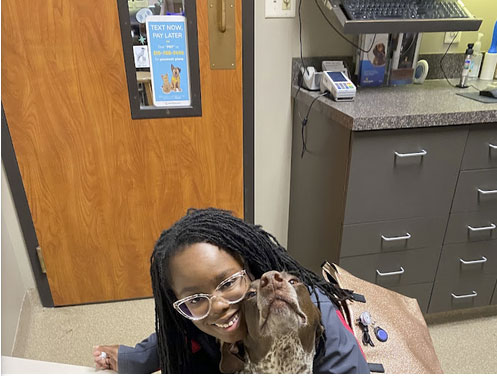
I can’t say enough about how wonderful the Doctors and the staff are. Our dog has had surgery on two knees TPLO - the first one was at another place - the experience here was so much better and less expensive. They thought of every comfort for our dog. We now drive 45 minutes each way for all 3 of our dogs because they get amazing care here. They are friendly and helpful from start to finish! We love Dr. DeMarco but have seen some of the other Doctors as well and have been impressed with all of them! – Elaine Boyd
I can't say enough kind words about the this clinic. Due to covid-19 restrictions I wasn't able to enter the facility, but I can say that the staff was very accommodating. Dr. Rodier is phenomenal -- I can see why he came so highly recommended. He performed a TPLO (tibial plateau leveling osteotomy on my 3-year-old pit bull, and came out to my car personally to go over the details and take my baby inside. He even called me after her surgery was complete to let me know how it went. Amazing people, every last one kind and understanding of my anxiety over this major surgery. It's been just over a week, and my girl is doing well. I'm confident Dr. Rodier was the exact surgeon I'd hoped to find. Well worth the 3+ hour drive there (and back, a few times when it's all said and done). Thank you, Dr. Rodier and crew at Blue Springs!
We had a great experience with Blue Springs Animal Hospital and Dr. Rodier, and would highly recommend them. Our 18 month old, 120 lb Great Dane had been limping and my vet suspected a torn CCL. He suggested going to a specialty vet for an MRI, due to his size. When I took him in to the specialty vet, the surgeon spent 5 minutes with my dog, told me his CCL was torn, and that he needed a $6,000 TPLO surgery with a 12-14 week, difficult recovery. He didn’t bother reviewing the x-ray results or do an MRI, just a quick physical check on the knee. I didn’t feel comfortable with that, and went to Dr. Rodier for a second opinion. He took his time working with my pup, looked at the x-rays, and suggested taking another round to see what was really going on. After a detailed review, he diagnosed that Stanley had a cracked tibia, and his knee was fine. His recommendation was 4-6 weeks of rest, with anti-inflammatories and pain meds. No surgery or extensive recovery for a large, hyper puppy. He also pointed out that if he’d tried to do the TPLO surgery, it would have gone very badly, due to the cracked tibia. After taking his advice and giving Stanley some time to heal, he’s no longer limping and is doing great on the knee. We really appreciated that Dr. Rodier took the time to diagnose what was really going on, didn’t jump to a conclusion that led to a pricey surgery, and spared our large pup from 12 weeks of kennel time and a difficult recovery for a surgery he didn’t truly need. While we love our current vet and will continue going there, for anything that they can’t handle, Dr. Rodier and Blue Springs Animal Hospital will be our next call.
We have used Dr. Rodier for two TPLO surgeries on our big Labrador. He has always worked with us and our dog never acts scared coming here, which is great. We recommend him to anyone needing a surgeon. - Jacob Adair
I had an initial consultation, then scheduled a tplo surgery for my dog. They gave total pricing up front, told me where I could get some medications on the economy, which saves money, then called after surgery to tell how he had done. They also covered additional issues along with post-op procedures. I would definitely recommend them. - Susan Kelb
My experience had to do with my beloved dog Sable hurting her hind leg and becoming completely lame in it. Sable had a previous TPLO surgery so I was extremely worried. After doing my research, I decided making the drive from Johnson County to Blue Springs, MO was my best shot. Dr. Joe Rodier was assigned to take care of Sable; rightfully so as his resume of experience is very much tailored to Sable's injury. I felt as though Dr. Joe Rodier had true compassion for my dog's plight and did all the right things to diagnose her and keep her pain free. Sable needed Xrays that required a radiologist to review them; which took a couple days. Within a half hour of the results coming in, Dr. Joe Rodier contacted me because he knew I was really worried. What a stand up guy. As of right now, Sable is still being treated and surgery may be required, but she is pain free and her demeanor is back to normal. The front desk staff was very helpful and showed empathy when Sable came limping in for her appointments. Thank you Dr. Joe Rodier and thank you Blue Springs Animal Hospital for taking care of my Sable. - Thomas Lambert
So grateful for Dr. Rodier and staff for taking care of my pup. We are 10 days post op on our second TPLO and I couldn't recommend them more. - Katherine Fuller
We've been long time customers with multiple pets. BSAH has been with us through a TPLO surgery, regular checkups and lots of pet resort stays. They even helped us during an after hours, last minute texting discussion while we picked out a puppy! We will be loyal customers for the forseeable future! - Kim Witt

We met with Dr Rodier to discuss the possibility of TPLO surgery for our dog with a partial CCL tear. Initially we spoke to Dr Rodier on the phone with our concerns before we scheduled the appointment. He was patient and answered all our questions, we never felt rushed and booked an appointment to do a physical exam. The physical exam was the same process, not rushed and very thorough. He listened and went over different options and recommendations and took the time to explain everything. He told us our dog was not a candidate for surgery at this time which was such a relief and made us feel very trusting that this vet office is truly look out for the wellbeing of our animal vs trying to cash in on a big surgery. We fully recommend and will be back in the future.
Dr Joe and the staff could not have done a better job on our dog’s TPLO surgeries- both legs! Extremely satisfied! - John Cain
Good decision made to shop around for my dogs ACL repair surgery . Made 3 calls and was most impressed with Blue Springs Animal Hospital. I was able to speak directly to Dr. Rodier , board certified surgeon . He took alot of time explaining the various stages of the surgery and post care needs , as well as explaining the price and sticking with that price when the surgery was finished . The vet techs are very friendly and patient in answering the questions I had after the surgery and addressed my concerns in a very courteous and professional manner . I'm very pleased with the decision that I made . My Gracie is doing very well and her leg seems to be healing nicely . Thanks again to all who were involved at Blue Springs Animal Hospital !! - Scott Howard
From the time our Dewey had surgery on his knee as a new puppy straight to today 4 years later, Blue Springs Animal Hospital, Dr. Rodier, and the entire staff have been fabulous. No mater if it is a routine check up or major surgery we feel like we are in the best hands. From the moment we call for an appointment we feel our concerns are addressed by everyone. We won’t take our little guy anywhere else, the 45 minute drive is nothing when we feel so confident in their care and the wonderful outcome for our Dewey. - Sharon Cox
I have been to Blue Springs Animal Hospital for 2 issues with my Golden retriever "Beaux ", first for ACL surgery with Dr Rodier. Great surgeon one of best in KC area. I was 100% satisfied with the quality of care, the professionalism of staff and cost. Follow up visits were great. Make sure you follow Dr Rodier after surgery instructions. 2nd time a couple of years later. Beaux wasn't eating and lethargy. She saw Dr Ryder he was excellent. - Mamie Haddock

Amazing staff! Kept me informed the whole time how my dog was doing after his knee surgery. Dr. Rodier did amazing work again for my dogs second knee surgery. I recommend him and the staff for any needs that your fur baby may need.

Our dog had torn his ACL and Dr. Rodier was great at recognizing it, recommending a couple options, and providing the surgery. Prior to the surgery, our dog couldn't put weight on his hind leg, and the day after he was already trusting his leg. Dr. Rodier was honest and upfront about everything. The pricing was on target with what I had seen online (sometimes cheaper than what I saw). I have been taking my dogs there for over 3 years and have not had a bad experience yet. - Anonymous

My dog had to have a special knee surgery called a TPLO. She received excellent care from Dr. Rodier and his staff. Her surgery was a success and she had a speedy recovery. The hardest part was keeping her from overdoing it during her recovery because she felt so much better right after surgery. The only other hospital in the area that could do the surgery was a hospital in Kansas that would have cost almost double. I know my pets will always receive the best care from Dr. Rodier and the Blue Springs Animal Hospital. - Anonymous
Read Meredith B.'s review of Blue Springs Animal Hospital & Pet Resort on Yelp
References and Additional Reading
- Witsberger T.H., Villamil J.A., Schultz L.G., Hahn A.W., Cook J.L. Prevalence of and risk factors for hip dysplasia and cranial cruciate ligament deficiency in dogs. Journal Of The American Veterinary Medical Association 2008;232:1818–1824. doi: 10.2460/javma.232.12.1818. [PubMed] [CrossRef] [Google Scholar] [Ref list]
- Spinella G, Arcamone G, Valentini S. Cranial Cruciate Ligament Rupture in Dogs: Review on Biomechanics, Etiopathogenetic Factors and Rehabilitation. Veterincary Sciences, 2021 Sep 6;8(9):186. doi: 10.3390/vetsci8090186. PMID: 34564580; PMCID: PMC8472898. [PubMed] [CrossRef] [Google Scholar]
- Wilke, V. L., Conzemius, M. G., Kinghorn, B. P., Macrossan, P. E., Cai, W., & Rothschild, M. F. (2006). Inheritance of rupture of the cranial cruciate ligament in Newfoundlands.Journal Of The American Veterinary Medical Association, 228(1), 61-64. Retrieved Feb 7, 2024, from https://doi.org/10.2460/javma.228.1.61
- American College of Veterinary Surgeons. Cranial Cruciate Ligament Disease. Available at: https://www.acvs.org/small-animal/cranial-cruciate-ligament-disease
- VASSEUR, P.B. (1984), Clinical Results Following Nonoperative Management for Rupture of the Cranial Cruciate Ligament in Dogs. Veterinary Surgery. 13: 243-246. https://doi.org/10.1111/j.1532-950X.1984.tb00801.x
- Wucherer KL, Conzemius MG, Evans R, Wilke VL. Short-term and long-term outcomes for overweight dogs with cranial cruciate ligament rupture treated surgically or nonsurgically.Journal Of The American Veterinary Medical Association 2013 May 15;242(10):1364-72. doi: 10.2460/javma.242.10.1364. PMID: 23634680. https://pubmed.ncbi.nlm.nih.gov/23634680/
- Christopher, SA, Beetem, J, Cook, JL. 2013. Comparison of long-term outcomes associated with three surgical techniques for treatment of cranial cruciate ligament disease in dogs. Veterinary Surgery. 42(3):329-34. Abstract available at: https://www.ncbi.nlm.nih.gov/pubmed/23432511
- Bergh MS, Peirone B. Complications of tibial plateau levelling osteotomy in dogs. Vet Comp Orthop Traumatol. 2012;25(5):349-58. doi: 10.3415/VCOT-11-09-0122. Epub 2012 Apr 25. PMID: 22534675. https://pubmed.ncbi.nlm.nih.gov/22534675/
- University of Missouri College of Veterinary Medicine. Cranial Cruciate Ligament Disease and the Tibial Plateau Leveling Osteotomy (TPLO). Available at https://vhc.missouri.edu/small-animal-hospital/surgery/cranial-cruciate-ligament-disease-and-the-tibial-plateau-leveling-osteotomy-tplo/
- Colorado State University Veterinary Teaching Hospital. Cranial Cruciate Ligament Injury. Available at https://vetmedbiosci.colostate.edu/vth/services/orthopedic-medicine/canine-cruciate-ligament-injury/

